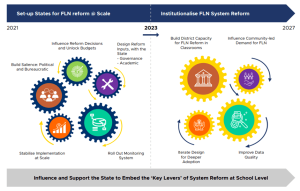In 2021, India took a bold and necessary step to reset the trajectory of its education system. The launch of the NIPUN Bharat Mission marked the first time the nation set a time-bound goal to ensure that every child in Grade 3 attains foundational literacy and numeracy (FLN) by 2026–27. Four years later, this National Mission has evolved from vision to action, from planning to palpable shifts in the teaching learning process. Today, with the groundwork firmly in place, the question is no longer whether foundational learning matters, it is how to sustain the momentum and deepen the gains already achieved. This is where strong governance can play a role.
Over the past four years, governments at both the Centre and in states have worked in unprecedented alignment to strengthen foundational learning for every child in India. The Ministry of Education has led the way—setting clear national goals and defining critical competencies through the National Curriculum Framework (NCF), laying out learning benchmarks through initiatives like the Foundational Learning Study (FLS), and creating robust monitoring systems like the Vidya Samiksha Kendras (VSKs).
These efforts have provided states with both a roadmap and the flexibility to adapt it to their unique contexts. States, in turn, have responded with creativity and commitment—while Odisha developed multilingual learning materials for diverse classrooms, Uttar Pradesh put in place a dedicated mentor cadre for supportive supervision of teachers. Together, this synergy between the national vision and local innovation is breathing life into classrooms and transforming learning for crores of children.
This effort has not only improved the visibility of foundational learning as a policy priority, but has also catalysed a shift in the culture of governance within the school education system.
Across the country, districts are beginning to use real-time data to drive student learning. In Uttar Pradesh, the NIPUN Lakshya App and NIPUN Prerna Gunvatta App allows mentors to digitally record classroom observations and helps teachers track student outcomes, enabling targeted support.

In Madhya Pradesh, the Textbook Vitran Tracking App helps school leaders monitor textbook delivery and quickly resolve supply chain issues—ensuring no child is left without learning materials.
At the classroom level, teachers are embracing structured pedagogy. States have rolled out lesson plans and teaching guides that simplify instruction and help measure learning progress more effectively. Beyond the classroom, parental engagement is becoming a real force multiplier. From model parent-teacher meetings to NIPUN Bihar’s NIPUN Gram Sabhas in Panchayats, communities are now becoming active partners in bolstering children’s education.
But, the real measure of success is not in the launch of a mission—it is the legacy created.
So, what does it take to embed foundational learning into the very DNA of an education system? Global experiences offer clues. Countries like Singapore, Vietnam, Kazakhstan and the United Kingdom (UK) have shown that there is no one-size-fits-all model. Yet, a common thread runs through their stories: lasting change is built on strong governance, institutional resilience and deep-rooted community ownership. These are not templates to replicate, but inspirations to adapt—reminding us that real transformation takes time, trust and teamwork.
Take Singapore, where the Ministry of Education leads with strategic direction, but schools enjoy autonomy in contextualising implementation. This balance has made Singapore one of the world’s most resilient systems. India, too, has achieved a similar dynamic through its centralised FLN frameworks and state-level flexibility, which must now evolve into a permanent governance model. Strengthening institutions like the State Council on Education Research and Training (SCERTs) and empowering head teachers with leadership training can further embed these practices.
Kazakhstan’s education reforms used a piloting approach to roll out a new skills-based curriculum. The government invested in phased implementation of this program, allowing for feedback loops and course corrections. India’s own phased rollout of the NIPUN Bharat Mission – beginning with assessments and progressing to building robust middle-level management for implementing the mission at the district-level to ensure health and fidelity of the system – has followed a similar arc. To build on this, real-time data systems such as the VSKs can shift from being compliance tools to adaptive learning systems. When districts use data not just to track but to learn, governance becomes generative.
Then there is Vietnam, where the concept of ‘socialisation’ in education places parents and communities at the heart of reform. School management committees and local education councils have been instrumental in mobilising resources and promoting accountability. India, with its vast diversity and decentralised education system, can take this principle further. The role of School Management Committees (SMCs), parents and communities can be reimagined – not as passive recipients of school plans, but as active agents in shaping learning environments, particularly in underserved areas.
Progress is only meaningful when it reaches every child. The UK’s focus on transparency and equity offers valuable lessons as India enters the next phase of its FLN journey. Regular school inspections and publicly available performance dashboards have fostered a culture of accountability centred on student learning. India has already pivoted towards systematically tracking actual learning outcomes across districts. A state-level or district-level FLN dashboard anchored in standardised, reliable assessments can help spotlight student progress, guide resource allocation and ensure that support reaches those who need it most.
This focus on learning outcomes must go hand in hand with a commitment to equity. Targeted interventions such as additional support for low-performing districts, multilingual materials for tribal regions and remedial or bridge programmes for children with learning gaps can be key to ensuring that progress under NIPUN Bharat is both inclusive and enduring. None of this can happen without investing in teachers. One of NIPUN Bharat’s most impactful contributions has been to reframe teacher training around clearly defined competencies. Programmes like NISHTHA have laid the foundation, but as countries like Singapore and Vietnam show, the real dividends come when professional development becomes continuous, contextual and personalised. India’s DIKSHA platform offers a digital backbone for this. What we need next is to formalise career-linked incentives, build peer learning networks and embed teacher well-being support to prevent burnout and ensure sustained engagement.
Beyond the classroom, technology and innovation must play a larger role in closing last-mile gaps. Haryana’s NIPUN Haryana Mentor App used to record school-wise spot assessment of students illustrate how digital tools can enhance quality and efficiency. With over 1.14 lakh assessments recorded through the app every month, this piece of technology has become the backbone of supportive supervision for teachers in the State.
Crucially, policy-research feedback loops must become the norm. Madhya Pradesh, for example, conducts cascaded review meetings every month where insights from the real-time dashboard is used to improve key metrics like usage of teacher guides, effectiveness of remediation programs etc. India already has a wealth of experience, data and academic expertise. What is needed now is a formal ecosystem that connects this evidence to policy action in real time.

The road ahead is both exciting and demanding. Over the last four years, the NIPUN Bharat Mission has demonstrated what is possible when vision, leadership and partnership converge. We must now build a future where foundational learning is not dependent on just missions with an end date on the horizon—but is woven into the core governance of education. A future where block-level officials use data for learning, where communities take pride in their schools, where teachers feel supported to grow and where every child—regardless of his/her socio-economic background—thrives by realising their best potential.
India is no longer in the phase of proving that foundational learning matters. We have already arrived at a consensus on “Why” FLN is important. This consensus is already showing impact. ASER 2024 results have shown that India has made the largest FLN gains in the last two decades, making us an exemplar for the world. What is required now is to focus on the “How” of FLN, making it imperative for decision makers to ensure that the gains are consolidated into the vision of a Viksit Bharat.
As the Kothari Commission observed, “The destiny of India is now being shaped in her classrooms.” Our governments can now seize the opportunity to ensure that those classrooms are governed by systems that are accountable, equitable and built to endure.



